Residents, commuters talk Red Line extension
Residents, commuters talk Red Line extension
November 7, 2016
South Side residents have expressed concerns about how the Chicago Transit Authority’s Red Line expansion will affect their homes and businesses, as the multi-billion-dollar project extends the line several miles further south.
Residents and Red Line users both attended a Nov. 1 public hearing to discuss the expansion at St. John Missionary Baptist Church, 211 E. 115th Street, which was advertised widely on Red Line train cars. It focused on the required Environmental Impact Statement currently in draft that describes how the project will affect the area around potential project zones.
The RLE Project is expected to cost approximately $2.3 billion and will extend 5.3 miles from its current terminus at 95th Street and the Dan Ryan Expressway to 130th Street, according to the CTA website. Four new stations will be built on 103rd Street, 111th Street, Michigan Avenue, and 130th Street.
In 2017, the CTA will begin the final stage of the Environmental Impact Statement process by conducting initial engineering and analysis of the area as well as additional outreach, which could take another two years. Once that is finished, the CTA will ask the Federal Transit Administration for an expected 49 percent contribution to the RLE project and will investigate other options to pay for the remaining 51 percent.
Leah Mooney, CTA’s Director of Strategic Planning and Policy, said she hopes the state will provide the needed funding.
The [RLE] project will start “as early as 2022, and [will be] finally completed in 2026,” said CTA spokeswoman Tammy Chase, “That is the goal.”
Doris White, a North Side resident and hearing attendee who commutes to the South Side for church and babysitting, said the extension is long overdue.
“It would’ve been nice if they had this project implemented a long time ago,” White said. “Why do we have to be the last on the totem pole to get this project?”
According to multiple CTA officials at the public hearing, the two current options for the RLE’s alignment is on either the east or west side of the city’s Union Pacific Railroad.
The east option is primarily residential and estimated to cost $2.26 billion. The west area is mostly businesses, and is estimated to cost $2.3 billion, according to the EIS draft on the Transit Chicago website.
In the United States, any level of government is allowed to take private property for public purposes through a legal concept called eminent domain. The constitution requires property owners to be fairly compensated.
Aaron Mallory, a South Side resident who recently purchased property on the east side of the UPRR, said he is concerned that CTA officials have already made the route decision—one he is not particularly pleased with.
“It seems that they may pick the east side because you look at the number, [and] there’s a lot more businesses on the west side,” Mallory said.
Mooney said each option has its pros and cons, and she has not heard a final decision.
“The west side has more commercial displacements,” Mooney said. “But there are issues to consider as well in terms of access to different neighborhoods.”
Mooney said she heard a lot of positive feedback and that people are looking forward to the extension despite some complications choosing its alignment.
“There will be some pain, but generally people are really positive about it,” Mooney continued.
Although Mallory is nervous for his property to be taken away if the east option is approved, he said he still sees multiple benefits of the RLE Project.
“I don’t want to stagnate it because I do see the benefits economically, what it will have for the area,” Mallory said, “I don’t want to be a barrier for it to be successful.”








